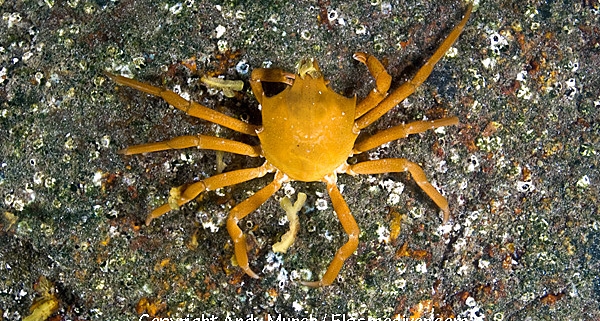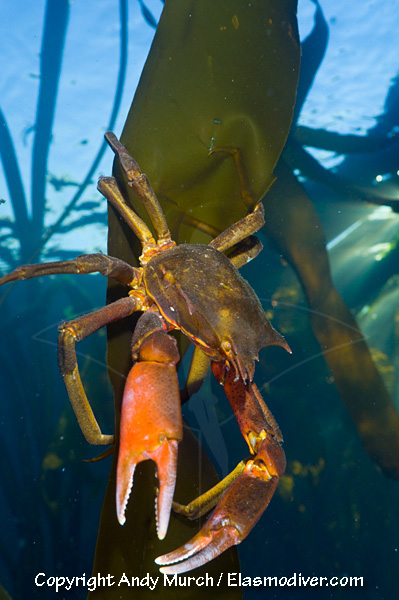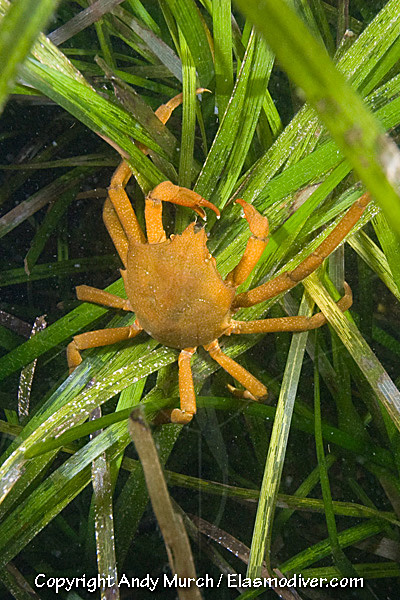Northern Kelp Crab
Common name: Northern Kelp Crab, Shield-Backed Kelp Crab
Scientific name: Pugettia producta
Size range: Carapace 7.8-9.3 cm across, with differing appendage sizes
Author: Ruby Wallace
Photography: Thank you to Andy Murch for permission to use his photos on our page!
Identifying Features: Northern Kelp Crab are part of a superfamily of crabs called the Majoidea (spider crabs) and are most easily identified by their shield-shaped carapace and 4 long, hairless walking legs. Telling the difference between males and females is hard, but generally male Northern Kelp Crabs have a bigger carapace, averaging at about 9.3 cm across, and females about 7.8 cm across. The second pair of their legs is the strongest and longest, being up to 1 ½ times their body length. Adult Northern Kelp Crabs are brown or red in colour, while juveniles are greenish-yellow. Unlike other crabs such as the Graceful Kelp Crab (Pugettia gracilis) who also have a shield-like carapace, the carapace of the Northern Kelp Crab is uniquely smooth and hard. The underside of the Northern Kelp Crab is usually red and/or yellow. You can sometimes tell when a Northern Kelp Crab hasn’t molted in awhile if their body is covered in the white and grey, mold-like appearance of invasive colonial tunicates. A Northern Kelp Crab after its terminal molt will often be covered in barnacles.
Habitat: Northern Kelp Crabs live primarily along the West Coast of North America, from Southern Alaska to Northern Mexico. They occupy kelp beds and forests and are especially common in swaths of Bull Kelp. Juveniles have been spotted in tide pools or smaller beds of Rockweed or Surf grass. Adults can be found anywhere from intertidal zones, up to 73 meters down. At times, they are seen at wharf pilings.
Food (Prey): Generally, the Northern Kelp Crab is a nocturnal feeder. Most of the year, it is a herbivore and feeds on Kelps, seaweeds such as the red algae primarily in the spring and summer. One unique behaviour of the Northern Kelp Crab is that it does not camouflage on purpose like the Graceful Decorator Crab (Oregonia gracilis) or the Graceful Kelp Crab (Pugettia gracilis) does by covering their carapace in kelp. This is probably because the Northern Kelp Crab is faster and larger and has less need for strategic camouflage. The only time the Northern Kelp Crab is observed exhibiting this behaviour is to hold onto their food through the day – similar to a backpack – and only taking bites when needed, while freeing up the pincers for defense and communication. During the Winter months, when the kelp beds and algae have decreased in volume, Northern Kelp Crabs turn to a mainly animal-based diet of barnacles, bivalves, hydroids, and bryozoans.
Predators: Sea otters are the most common predator of the Northern Kelp Crab, as they are in heavy abundance in most kelp forests. Other predators include the Staghorn Sculpin, various gulls, and cabezons. Oftentimes the Zoea larvae of Northern Kelp Crabs are eaten by Velella velella. Parasites are also an issue for Northern Kelp Crabs, one such parasite; the Heterosaccus californicus causes the Northern Kelp Crab to become sluggish, and destroys the male reproductive organs. In turn, many males become hermaphroditic and develop female reproductive organs. One defense against predators that the Northern Kelp Crab possesses is its speed and relatively aggressive nature. Its pincers and hard carapace also offer some protection.
Life Cycle: Adult Northern Kelp Crabs migrate to deeper waters in the Fall to mate. Once the eggs of a female have been fertilized, they are stored in her abdombale sac, also called an pron. Females can be seen throughout the seasons carrying eggs. One clutch from a female can contain anywhere from 34,000 to 84,000 eggs. At first, the eggs are bright orange, then become red, and finally, before hatching, the eggs will become grey and purple. This process can take anywhere from 2 weeks to a month. After being hatched, the zoea larvae will drift away and develop into megalopae, and then into juveniles where they take on the green/yellow colouration. Embryonic development of Northern Kelp Crabs varies wildly but usually the entire process takes about 1 year.
Fun Facts:
- Like most Brachyura, the Northern Kelp Crabs cannot osmoregulate (cannot regulate internal balance of disolvants and fluid relative to surroundings) and therefore cannot survive in brackish water
- Though not considered a popular crab for commercial fishing, the taste of a Northern Kelp Crab has been described as “sweet” and the texture “stringy”
References:
Cowels, D. (2005) Pugettia producta (Randall, 1839). Invertebrates of the Salish Sea. Retrieved January, 29, 2022 from https://inverts.wallawalla.edu/Arthropoda/Crustacea/Malacostraca/Eumalacostraca/Eucarida/Decapoda/Brachyura/Family_Majidae/Pugettia_producta.html
NorCal. (Dec, 2005). Are Kelp Crabs Edible?. NorCal Kayak Anglers. Retrieved January, 29, 2022 from http://www.norcalkayakanglers.com/index.php?topic=42781.0#:~:text=IF%20these%20are%20the%20red,any%20crab%20I’ve%20eaten.
SanctuarySimon.org. (2002). Kelp Crab Pugettia producta. Explore California Sanctuaries. Retrieved January, 29, 2022 from https://sanctuarysimon.org/dbtools/species-database/species-info-ajax.php?sID=169#:~:text=Adult%20Pugettia%20producta%20lives%20mostly,about%2073%20meters%20in%20depth.
University of Puget Sound. (2022). Kelp Crab (Pugettia producta). Slater Museum of Natural History. Retrieved January 29, 2022 from https://www2.pugetsound.edu/academics/academic-resources/slater-museum/exhibits/marine-panel/kelp-crab/







Leave a Reply
Want to join the discussion?Feel free to contribute!